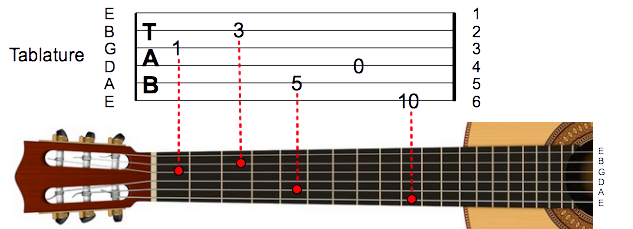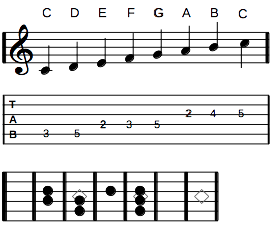There are a number of ways to write or notate music for the guitar. The most useful one to learn is standard musical notation because that is used by all musicians universally regardless of what instrument they play. For beginners and intermediate players, it’s also useful to be familiar with tablature notation (abbreviated as TAB) and fretboard or chord diagrams.
Tablature (TAB)
TAB notation is a graphical format where each horizontal line represents a string, with the high E string at the top and the low E string at the bottom:

Numbers located on a line indicate the fret position to be held down at that string. For example, a 3 on the second line from the top means to hold down the B string at the third fret. A zero on a line means to play an open string for the indicated string:

When numbers appear one after another, this indicates that they are played in sequence from left to right. If two or more numbers are stacked together, then this indicates notes that should be played together at the same time, for example, as a chord (more on this later).
Fretboard Diagrams
Fretboard diagrams are similar to tab notation. Each horizontal line represents a string, with the high E string at the top and the low E string at the bottom. Vertical lines represent frets. The leftmost vertical line represents the nut. White circles outside the diagram on the left indicate that an open string should be played. Black circles between two frets indicate that a string is to be held down at that position on the fretboard.
The diamond symbols below represent typical fret marker positions on the fretboard; however, not all guitars have fret markers or may have them in a different position. In most guitars, fret markers are located at the 3rd, 5th, 7th, 10th, 12th, 15th, and 17th frets.

Putting both examples together, we get:

Standard Musical Notation
Standard musical notation uses a staff consisting of five horizontal lines to represent the pitch for notes. Pitch is the frequency or relative “highness” or “lowness” of a note.

A clef sign at the beginning of a staff indicates the range of notes that are represented on the staff. Guitar notation uses a G clef (also known as a Treble clef) to indicate the range of notes. The vertical position of a note on the staff indicates how high or low that note is to be played. So a note appearing lower on the staff will have a lower pitch than notes appearing higher on the staff.

If necessary, ledger lines are placed below or above to extend the range of the staff. Notes are played from left to right indicating a sequence of notes. If two or more notes are stacked vertically on the staff, then those notes are played together at the same time. For example, as a chord or a harmony (more on this later). Putting together the three systems of notation described above, we get:

Copyright © 2014 Luis Rojas. All Rights Reserved.